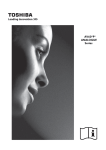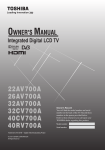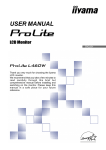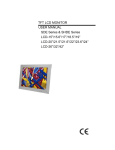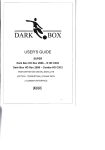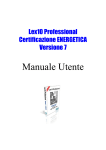Download Toshiba 19AV615D LCD TV
Transcript
AV61*D* DIGITAL Series Contents Safety Precautions ....................................... 3 Installation and important information ....... 4 Stable Sound® ....................................23 The remote control ....................................... 5 Audio Description ................................... 23 Inserting batteries and effective range of the remote ................................................. 6 Visually Impaired .................................... 23 Widescreen viewing ................................... 24 Connecting external equipment .................. 7 Picture controls .......................................... 26 Connecting an HDMI™ or DVI device to the HDMI input ..................................................... 9 Picture Mode ........................................... 26 To connect an HDMI device ..................... 9 Brightness, Contrast, and Colour ......... 26 DVI device to the HDMI Input ................. 11 Tint ........................................................... 26 Connecting a computer.............................. 13 Sharpness .............................................. 26 To connect a PC to the HDMI terminal .. 13 Colour Temperature ................................ 26 Using the controls ...................................... 15 Cinema mode .......................................... 26 Switching on ........................................... 16 DNR .......................................................... 27 Using the remote control ....................... 16 CTI ............................................................ 27 Using the controls .................................. 16 Flesh Tone ............................................... 27 Tuning the television .................................. 17 Adaptive Luma Control .......................... 27 Initial Setup ............................................. 17 Active Backlight ...................................... 27 Setting the programmes ............................ 18 Blue Screen ............................................. 27 Auto Scan ................................................ 18 Back Light ............................................... 28 Manual scan ............................................ 18 H. and V. Position.................................... 28 Channel Skip ........................................... 19 Timer control ............................................... 28 Update scan ............................................ 20 Time Zone ................................................ 28 Digital Channel Range Scan .................. 20 Time ......................................................... 28 Channel Sort ........................................... 20 Sleep Timer ............................................. 29 Channel Edit ........................................... 20 Input selection and AV connections ......... 30 Channel Decode ..................................... 21 Input selection ........................................ 30 Analogue Channel Fine Tune................. 21 Input signal selection ............................. 30 Common Interface .................................. 21 Function control ......................................... 31 Reset Default ........................................... 21 Analogue Subtitle ................................... 31 General controls ......................................... 21 Digital Subtitle ......................................... 31 Selecting programme positions ............ 21 Subtitle Type............................................ 31 Stereo and Bilingual transmissions ...... 21 Logo LED ................................................. 31 Audio Description ................................... 21 4:3 Stretch ............................................... 31 Quick Access Menu ................................ 22 Parental control .......................................... 31 Favourite List .......................................... 22 Channel Block ........................................ 31 Sound controls ........................................... 22 Programme Block ................................... 32 Volume ..................................................... 22 Input Block .............................................. 33 Balance, Bass, Treble ............................. 22 Panel Lock ............................................... 33 Surround Sound...................................... 23 Factory Default ........................................ 33 Bass Boost .............................................. 23 1 Digital on-screen information and Programme Guide....................................... 34 Information .............................................. 34 Guide ........................................................ 34 EPG Timer................................................ 34 Text services ............................................... 35 Setting the Language ............................. 35 Text Information ...................................... 35 Control buttons ....................................... 35 Teletext Favourite ................................... 35 Questions and Answers ............................. 36 Specifications and accessories ................ 38 Exhibit A................................................... 41 Exhibit B .................................................. 41 Notes ............................................................ 42 2 English SETTING UP Safety Precautions DO be careful with glass panels on equipment. This equipment has been designed and manufactured to meet international safety standards but, like any electrical equipment, care must be taken to obtain the best results and for safety to be assured. Please read the points below for your own safety. They are of a general nature, intended to help with all electronic consumer products and some points may not apply to the goods you have just purchased. The Class I apparatus shall be connected to a mains socket outlet with a protective earthing connection. DO NOT REMOVE ANY FIXED COVERS AS THIS WILL EXPOSE DANGEROUS AND 'LIVE' PARTS. THE MAINS PLUG IS USED AS A DISCONNECTING DEVICE AND THEREFORE SHOULD BE READILY OPERABLE. Do not DO NOT obstruct the ventilation openings of the equipment with items such as newspapers, tablecloths, curtains, etc. Overheating will cause damage and shorten the life of the equipment. Air Circulation Leave more than 10cm clearance around the television to allow adequate ventilation. This will prevent overheating and possible damage to the television. Dusty places should also be avoided. DO NOT allow electrical equipment to be exposed to dripping or splashing or objects filled with liquids, such as vases, to be placed on the equipment. Heat Damage DO NOT place hot objects or naked flame sources, such as lighted candles or nightlights on, or close to equipment. High temperatures can melt plastic and lead to fires. Damage may occur if the television is left in direct sunlight or near a heater. Avoid places subject to extremely high temperatures or humidity. Place in a location where the temperature remains between 5°C (41°F) min. and 35°C (94°F) max. DO NOT use makeshift stands and NEVER fix legs with wood screws. To ensure complete safety, always fit the manufacturers’ approved stand, bracket or legs with the fixings provided according to the instructions. Mains Supply The mains supply required for this equipment is 220-240v AC 50/60Hz. Never connect to a DC supply or any other power source. DO ensure that the television is not standing on the mains lead. Use only the supplied lead. DO NOT cut off the mains plug from this equipment, this incorporates a special Radio Interference Filter, the removal of which will impair its performance. In the UK, the fuse fitted in this plug is approved by ASTA or BSI to BS1362. It should only be replaced by a correctly rated and approved type and the fuse cover must be refitted. IF IN DOUBT PLEASE CONSULT A COMPETENT ELECTRICIAN. DO NOT leave equipment switched on when it is unattended, unless it is specifically stated that it is designed for unattended operation or has a standby mode. Switch off by withdrawing the plug, make sure your family know how to do this. Special arrangements may need to be made for people with disabilities. DO NOT continue to operate the equipment if you are in any doubt about it working normally, or it is damaged in any way – switch off, withdraw the mains plug and consult your dealer. WARNING – excessive sound pressure from earphones or headphones can cause hearing loss. Do DO read the operating instructions before you attempt to use the equipment. DO ensure that all electrical connections (including the mains plug, extension leads and inter-connections between pieces of equipment) are properly made and in accordance with the manufacturers’ instructions. Switch off and withdraw the mains plug before making or changing connections. DO consult your dealer if you are ever in doubt about the installation, operation or safety of your equipment. ABOVE ALL – NEVER let anyone, especially children, push or hit the screen, push anything into holes, slots or any other openings in the case. NEVER guess or take chances with electrical equipment of any kind – it is better to be safe than sorry. 3 SETTING UP Where to install Sturdy tie Locate the television away from direct sunlight and strong lights, soft, indirect lighting is recommended for comfortable viewing. Use curtains or blinds to prevent Hook direct sunlight falling on the screen. Place the TV set on a stable, level surface that can support the weight of the TV. As an additional safety measure you can secure the Top View Side View TV to the level surface or a wall, as shown in the illustration, using a sturdy strap. The LCD display panels are manufactured using an extremely high level of precision technology, however sometimes some parts of the screen may be missing picture elements or have luminous spots. This is not a sign of a malfunction. Make sure the television is located in a position where it cannot be pushed or hit by objects, as pressure will break or damage the screen, and that small items cannot be inserted into slots or openings in the case. Wall mounting of the TV should only be performed by qualified servicing personnel. Use only with the wall mount bracket specified by the manufacturer. Please take note EXCLUSION CLAUSE Toshiba shall under no circumstances be liable for loss and/or damage to the product caused by: i) fire; ii) earthquake; iii) accidental damage; iv) intentional misuse of the product; v) use of the product in improper conditions; vi) loss and/or damage caused to the product whilst in the possession of a third party; vii) any damage or loss caused as a result of the owner’s failure and/or neglect to follow the instructions set out in the owner’s manual; viii) any loss or damage caused directly as a result of misuse or malfunction of the product when used simultaneously with associated equipment; Furthermore, under no circumstances shall Toshiba be liable for any consequential loss and/or damage including but not limited to the following, loss of profit, interruption of business, the loss of recorded data whether caused during normal operation or misuse of the product. NOTE: A Toshiba wall bracket or stand, where available must be used. If a non Toshiba wall bracket or stand is used the product's BEAB approval will become void and the equipment is then used at the consumers own risk. • The digital reception function of this television is only effective in the countries listed in the "Country" section of the "SETUP" menu. Depending on country/area, some of this television's function may not be available. Reception of future additional or modified services can not be guaranteed with this television. • If stationary images generated by 4:3 broadcasts, text services, channel identification logos, computer displays, video games, on screen menus, etc. are left on the television screen for any length of time they could become conspicuous, it is always advisable to reduce both the brightness and contrast settings. • Very long, continuous use of the 4:3 picture on a 16:9 screen may result in some retention of the image at the 4:3 outlines, this is not a defect of the LCD TV and is not covered under the manufacturers warranty. Regular use of other size modes (eg: Superlive) and varying the “side panel” brightness (if available on the model) will prevent permanent retention. 4 English Installation and important information English SETTING UP The remote control Simple at-a-glance reference of your remote control. 2 3 4 1 2 3 4 1 5 6 5 6 7 8 9 10 11 12 7 8 9 12 10 11 14 16 13 15 18 17 19 13 14 15 16 17 18 19 20 20 5 For On/Standby mode To select input from external sources Still Picture To call up text services in analogue mode and interactive services in digital mode To turn the subtitle On/Off Stereo/Bilingual transmissions Number buttons Switch the Audio Description On/Off No Function To alter the volume To change programme In TV mode: To display on screen information In Text mode: To access index page To mute the sound To display Quick access menu To exit menus To display the programme guide To return to the previous level of the onscreen menu To display the on-screen menu ▲, ▼, ◄, ►: To move Up, down, left or right in the on-screen menu OK: To confirm the selection Colour button: Text control buttons To reveal concealed text To hold a wanted page To enlarge text display size In normal picture mode: To display clock on TV screen. In Teletext mode: To toggle between Telextext and normal picture mode SETTING UP English Inserting batteries and effective range of the remote Remove the back cover to reveal the battery compartment and make sure the batteries are inserted the right way round. Suitable battery types for this remote are AAA, IEC R03 1.5V. Do not combine a used, old battery with a new one or mix battery types. Remove dead batteries immediately to prevent acid from leaking into the battery compartment. Dispose of them in accordance with instructions on page 42 of this manual. Warning: batteries must not be exposed to excessive heat such as sunshine, fire or the like. The performance of the remote control will deteriorate beyond a distance of five metres or outside an angle of 30 degrees from the centre of the television. If the operating range becomes reduced the batteries may need replacing. 6 English SETTING UP Connecting external equipment Before connecting any external equipment, turn off all main power switches. If there is no switch remove the mains plug from the wall socket. Connect the power cord into the AC IN socket found at the back of the TV. Model : 19/22 Only *a decoder could be Digital Satellite or any other compatible decoder. AC IN RGB/PC media recorder (1) COMPONENT Y decoder* PB/CB PR/CR L R PC/HDMI (AUDIO) AUDIO HDMI (3) NOTE: SCART can support Canal+ decoder. Model : 26/32/37 Only *a decoder could be Digital Satellite or any other compatible decoder. AC IN media recorder decoder* RGB/PC PC/ HDMI 1 (AUDIO) NOTE: SCART1 : SCART2 : 1 Y PB/CB PR/CR 2 L AUDIO HDMI 1/2 R (1) COMPONENT (3) (4) NOTE: SCART1 can support Canal+ decoder. 7 (3) (INPUT/TV OUT) OUT) (4) (INPUT/Monitor SETTING UP English Aerial cables: - - - - - - - - - - - - - - - - Connect the aerial to the ANT socket on the rear of the television. If you use a decoder and/or a media recorder it is essential that the aerial cable is connected through the decoder and/or through the media recorder to the television. SCART leads: - - - - - - - - - - - - - - - - Connect the video recorder IN/OUT or decoder TV socket to the television. Connect the media recorder SAT socket to the decoder MEDIA REC. socket. Before running Auto Scan put your decoder and media recorder to Standby. The phono sockets alongside the COMPONENT VIDEO INPUT sockets will accept L and R audio signals. The phono sockets alongside the VIDEO INPUT socket will accept L and R audio signals. These sockets are located on the side of the TV. (See page 15.) HDMI™ (High-Definition Multimedia Interface) is for use with a DVD, decoder or electrical equipment with digital audio and video output. It is designed for best performance with 1080i high-definition video signals but will also accept and display VGA, SVGA, XGA, WXGA, SXGA, 480i, 480p, 576i, 576p, and 720p signals. NOTE: Although this television is able to connect to HDMI equipment it is possible that some equipment may not operate correctly. A wide variety of external equipment can be connected to the back of the television, therefore the relevant owners manuals for all additional equipment must be referred to. If the television automatically switches over to monitor external equipment, return to normal television to select. by pressing the desired programme position button. To recall external equipment, press HDMI, the HDMI logo, and High-Definition Multimedia Interface are trademarks or registered trademarks of HDMI Licensing, LLC. 8 English SETTING UP Connecting an HDMI™ or DVI device to the HDMI input The HDMI input on your television receives digital audio and uncompressed digital video from an HDMI source device, or uncompressed digital video from a DVI (Digital Visual Interface) source device. This input is designed to accept HDCP (High-Bandwidth Digital- Content Protection) programme material in digital form from EIA/CEA-861-D–compliant [1] consumer electronic devices (such as a set-top box or DVD player with HDMI or DVI output). For acceptable video signal formats, see page 14. NOTE: • Some early HDMI equipment may not work properly with your latest HDMI TV, due to the adoption of a new standard. • Supported Audio format: Linear PCM, sampling rate 32/44.1/48kHz To connect an HDMI device Connect an HDMI cable (type A connector) to the HDMI terminal. For proper operation, it is recommended that you use an HDMI cable with the HDMI Logo ( ). • HDMI cable transfers both video and audio. Separate analogue audio cables are not required (see illustration). Model : 19/22 Only HDMI HDMI cable (not supplied) HDMI device HDMI out 9 SETTING UP English Model : 26/32/37 Only 1 HDMI device 2 HDMI 1/2 HDMI out To view the HDMI device video, press to select the mode. 10 HDMI cable (not supplied) English SETTING UP DVI device to the HDMI Input Connect an HDMI-to-DVI adapter cable (HDMI type A connector) to HDMI1 terminal and audio cables to the PC/HDMI1 Audio socket (see illustration). • The recommended HDMI-to-DVI adapter cable length is 6.6 ft (2m). An HDMI-to-DVI adapter cable transfers video only. • Separate analogue audio cables are required. Model : 19/22 Only PC/HDMI (AUDIO) HDMI Audio cable for HDMI to television connection (not supplied) HDMI-to-DVI adapter cable (not supplied) DVI device 11 SETTING UP English Model : 26/32/37 Only PC/ HDMI 1 (AUDIO) Audio cable for HDMI to television connection (not supplied) 1 2 HDMI 1/2 HDMI-to-DVI adapter cable (not supplied) DVI device NOTE: To ensure that the HDMI or DVI device is reset properly, it is recommended that you follow these procedures: • When turning on your electronic components, turn on the television first, and then the HDMI or DVI device. • When turning off your electronic components, turn off the HDMI or DVI device first, and then the television. [1] EIA/CEA-861-D compliance covers the transmission of uncompressed digital video with high-bandwidth digital content protection, which is being standardized for reception of highdefinition video signals. Because this is an evolving technology, it is possible that some devices may not operate properly with the television. HDMI, the HDMI logo and High-Definition Multimedia Interface are trademarks or registered trademarks of HDMI Licensing LLC. 12 English SETTING UP Connecting a computer With the HDMI connection, you can watch your computer’s display on the television and hear the sound from the televisions speakers. To connect a PC to the HDMI terminal When connecting a PC to the HDMI terminal on the television, use an HDMI-to-DVI adapter cable and analogue audio cables. If connecting a PC with an HDMI terminal, use an HDMI cable (type A connector). Separate analogue cables are not necessary (see page 9). Model : 19/22 Only the back of your television PC/HDMI (AUDIO) Computer HDMI-to-DVI adapter cable (not supplied) HDMI Audio cable for PC to television connection (not supplied) Model : 26/32/37 Only the back of your television PC/ HDMI 1 (AUDIO) Computer HDMI-to-DVI adapter cable (not supplied) 1 2 HDMI 1/2 Audio cable for PC to television connection (not supplied) For acceptable PC signal formats, see “Acceptable PC signals through HDMI terminals” on page 14. NOTE: The edges of the images may be hidden. 13 SETTING UP English Acceptable Video signals through HDMI terminals Format Resolution V. Frequency H. Frequency Pixel Clock Frequency 480i 720 x 480i 60.000Hz 15.734kHz 27.000MHz 480p 720 x 480p 60.000Hz 31.500kHz 27.000MHz /27.030MHz 576i 720 x 576i 50.000Hz 15.625kHz 27.000MHz 576p 720 x 576p 50.000Hz 31.250kHz 54.000MHz 720p 1280 x 720p 50.000Hz 37.500kHz 74.250MHz 720p 1280 x 720p 59.940 Hz / 60.000Hz 44.960kHz / 45.000kHz 74.170MHz /74.250MHz 1080i 1920 x 1080i 59.940 Hz / 60.000Hz 33.720kHz / 33.750kHz 74.170MHz /74.250MHz 1080i 1920 x 1080i 50.000Hz 28.125kHz 74.250MHz Acceptable PC signals through HDMI/D-SUB terminals Format Resolution V. Frequency H. Frequency Pixel Clock Frequency VGA 640x480 59.940Hz 31.469kHz 25.175MHz VGA 640x480 72.809Hz 37.861kHz 31.500MHz VGA 640x480 75.000Hz 37.500kHz 31.500MHz VGA 720x400 70.087Hz 31.469kHz 28.322MHz SVGA 800x600 56.250Hz 35.156kHz 36.000MHz SVGA 800x600 60.317Hz 37.879kHz 40.000MHz SVGA 800x600 72.188Hz 48.077kHz 50.000MHz SVGA 800x600 75.000Hz 46.875kHz 49.500MHz XGA 1024x768 60.004Hz 48.363kHz 65.000MHz XGA 1024x768 70.069Hz 56.476kHz 75.000MHz XGA 1024x768 75.029Hz 60.023kHz 78.750MHz WXGA 1280x720 59.855Hz 44.772kHz 74.250MHz WXGA 1280x768 59.870Hz 47.776kHz 79.500MHz WXGA 1360x768 60.015Hz 47.712kHz 85.500MHz SXGA 1280x1024 60.020Hz 63.981kHz 108.000MHz HDMI, the HDMI logo, and High-Definition Multimedia Interface are trademarks or registered trademarks of HDMI Licensing, LLC. NOTE 1: HDMI 1 terminals supports PC signal input, HDMI 2 and 3 does not support PC signal. NOTE 2: For PC input, for only supported PC signal can show the correct resolution on TV display. 14 Using the controls Whilst all the necessary adjustments and controls for the television are made using the remote control, the buttons on the television may be used for some functions. Note: COMMON INTERFACE (CI) The common interface is for a Conditional Access Module (CAM) Contact a service provider for details. Model : 19/22 Only DVB COMMON INTERFACE CI Card Power Programme up Programme down R VIDEO INPUT L Volume up R AUDIO English SETTING UP Volume down MENU L Menu Video VIDEO Input OK (2) Service Only SERVICE ONLY Headphone GREEN LED - On Timer/EPG Timer On IR SENSOR RED LED - Standby GREEN LED - Power on Model : 26/32/37 Only DVB COMMON INTERFACE CI Card Power Programme up Programme down R L L Volume up AUDIO VIDEO INPUT R Volume down MENU Menu Video VIDEO OK (2) Input Service Only SERVICE ONLY Headphone HDMI 3 HDMI 3 RED LED - Standby GREEN LED - Power on IR SENSOR GREEN LED - On Timer/EPG Timer On 15 SETTING UP English Switching on If the RED LED is unlit check that the mains plug is connected to the power supply. If the picture does not appear press on the remote control, it may take a few moments. To put the television into Standby press on the remote control. To view the television press again. The picture may take a few seconds to appear. Using the remote control To set up the television you will now need to use the on screen menus. Press to see the menus. on the remote control The on-screen menu appears as a list of five topics. As each symbol is selected by pressing ◄ or ►on the navigation ring on the remote control, its respective options will appear below. To use the options, press or on the navigation ring to move up and down through them and use , ◄ or ► to select the required choice. Follow the on-screen instructions. The functions of each menu are described in detail throughout the manual. Using the controls To alter the volume press – +. To alter the programme position press P . Press and , , ◄ or ► to control the sound and picture options. Press to finish. and then use To select the external input, press or to move through the list until the appropriate input source is selected as described on page 30. Please always refer to the owner’s manual of the equipment to be connected for full details. Please note: Inserting the headphone plug will mute the sound from all speakers. 16 English TUNING THE TELEVISION 4 Tuning the television To start channel scan press ►. Initial Setup Before switching on the television put your decoder and media recorder to Standby if they are connected. To set up the television use the buttons on the remote control as detailed on page 5. Channel Scan First, please connect antenna. If you skip this step, the channel scan can be performed in the TV Menu. Initial Setup 0% Back Connect the television to the main power and press the button. The Initial Setup screen will appear at the first use. Press to start the initial setup Initial Setup Using ▲ or ▼ to select your language, and then press ►. Initial Setup Exit NOTE: The time will be set automatically using the broadcaster data but can be advanced or decreased by up to 12 hours using Time Zone in Timer. (See page 28) PLEASE NOTE Language Please select your language: The Factory Default menu can also be accessed at any time in the Parental from the FUNCTION menu. English Español Français Deutsch Italiano Ελληνικά Български Next EXIT Exit Press ▲ or ▼ to select your country and press ► to the next step. Initial Setup Country Please select your country: United Kingdom Italy Luxembourg Netherlands Norway Sweden Bulgaria Select EXIT If the television cannot be connected to a media recorder/decoder with a SCART lead or if a station on another system is required, use Manual Scan to allocate a programme position, see page 18. Please press [OK] to start the wizard. Back Next NOTE: If you skip this step, the channel scan can be performed in the TV Menu. Welcome Select Select The search will begin for all available stations. The slide bar will move along the line as the search progresses. Welcome to the initial Setup wizard. Back Scan Skip Scan Start channel scan now ? Next EXIT Exit 17 TUNING THE TELEVISION Setting the programmes NOTE: When Channel Block is activated, the 4-digit password is needed to enter the Channels submenu under SETUP menu. English Select Auto Scan and press . Channels Auto Scan Update Scan Digital Channel Range Scan Analogue Manual Scan Channel Skip Channel Sort Channel Edit Channel Decode Analogue Channel Fine Tune Auto Scan Auto Scan will completely re-tune the television and can be used to update the channel list. It is recommended that Auto Scan is run periodically to ensure that all new services are added. OK Scan Select RETURN Back EXIT Exit NOTE: All current programmes and settings, i.e. favourites and locked programmes, will be lost. Press Cancel for no change, or press start Auto Scan. Press MENU and use ◄ or ► to select SETUP. .to Previous setting will be lost ! Press Cancel for no change, Press OK to start Auto scan. SETUP Country United Kingdom OSD Language English Audio Language English Audio Language 2nd English Channels Common Interface Reset Default OK Enter Select RETURN Back OK Manual scan EXIT Exit Press ▼ to highlight Country and use ◄ or ► to select. The television can be tuned-in manually using Manual scan. For example: if the television cannot be connected to a media recorder/ decoder with a SCART lead or to tune-in a station on another System. Press MENU and using ◄ or ► to select SETUP. NOTE: In order to receive the information from the broadcaster correctly, please set the correct country. Use ▼ to highlight OSD Language and press ◄ or ► to select. 4 SETUP Country United Kingdom OSD Language English Audio Language English Audio Language 2nd English Channels Common Interface Reset Default Press ▼ to highlight Channels and press ► or . SETUP United Kingdom Country OSD Language English Audio Language English Audio Language 2nd English Channels Common Interface Reset Default OK Enter Select RETURN Back EXIT Cancel OK Exit 18 Enter Select RETURN Back EXIT Exit English TUNING THE TELEVISION Press ▼ to highlight Channels and press ► or . In the SETUP menu press ▼ to highlight Channels and press ► or to select. SETUP Country United Kingdom OSD Language English Audio Language English Audio Language 2nd English Channels Common Interface Reset Default SETUP United Kingdom Country OSD Language English Audio Language English Audio Language 2nd English Channels Common Interface Reset Default Enter OK OK Enter Select RETURN Back EXIT 4 Select Back EXIT Exit Channels Auto Scan Update Scan Digital Channel Range Scan Analogue Manual Scan Channel Skip Channel Sort Channel Edit Channel Decode Analogue Channel Fine Tune Channels Auto Scan Update Scan Digital Channel Range Scan Analogue Manual Scan Channel Skip Channel Sort Channel Edit Channel Decode Analogue Channel Fine Tune Enter RETURN Press ▼ to highlight Channel Skip and press ► or to select. Select Analogue Manual Scan and press ► or to confirm it. OK Select Exit OK RETURN Back EXIT Enter Select RETURN Back EXIT Exit Use ▲ or ▼ to select the channels you want to skip, then press to set. Exit Using number buttons 0~9 to enter the Start Frequency. Use ▲ or ▼ to select Scan Up or Scan Down and press ► or to start scan. Press to stop scanning. 1 Digital Channel Skip TF1 Channel Skip To prevent certain programmes from being viewed, the programme position can be skipped. The remote control must be removed as the channels will still be available using the number buttons. Programmes can then be watched as normal using the controls on the television, but the television will not show the skipped programme position. OK Set Select RETURN Back EXIT Exit Skipped programme positions cannot be selected by P and P or by the controls on the television, but can still be accessed by the number buttons on the remote control. 19 TUNING THE TELEVISION Channel Sort Search the new channels that are not in the programme list. Change the order of the programme list. Select Channels from the SETUP menu. Press MENU and use ◄ or ► to select SETUP. Highlight Channel Sort and press ► or to select. Press ▼ to highlight Channels and press ► or . Select Update Scan and press scan. Pressing to check two channels to swap the positions. to start Digital Channel Range Scan 1 2 3 4 5 6 7 8 9 10 Scan channels from certain range. You can set the range before you scan the channels. Select Channels from the SETUP menu. Highlight Digital Channel Range Scan and press ► or to select. Digital Digital Digital Digital Digital Digital Digital Digital Digital Digital OK Using ▲, ▼, ◄ and ► to set the range, then press to scan. Set Channel Sort TF1 TMC NRJ12 LCI Eurosport France 24HTVE CLANTVE La2 TVE1 RNE1 Select RETURN Back EXIT Exit Channel Edit Edit the channel number and channel name. Digital Channel Range Scan Select Channels from the SETUP menu. Scan with a range of channels. Highlight Channel Edit and press ► or to select. 0% From Channel To Channel Using ▲ or ▼ to highlight the channel and press to select. 21 69 OK Scan RETURN Back EXIT 4 Exit Change the Channel Number by using the number buttons 0~9. Change the Channel Name by pressing the number buttons 0~9 to enter numbers and letters. NOTE: Colour System/Sound System can be changed only in Analogue TV. Channels Edit Network Name: R seau Num rique Terre Channel Number: 1 Channel Name: TF1 Frequency 490 Colour system Auto Sound system B/G OK 20 Set Select RETURN Back EXIT Exit English Update scan English TUNING THE TELEVISION Reset Default Channel Decode Selecting Reset Default will reset all TV settings to their original factory values, excludes Country, Language OSD, and Channels. Channel Decode support the Canal+ (paid television channel); however, the channel also broadcast some un-encrypted programmes. These programmes without encryption can be viewed free of charge. In the SETUP menu press ▼ to highlight Channels and press ► or to select. Select OK to confirm or select Cancel to exit. Select Channels from the SETUP menu. Highlight Channel Decode and press ► or to select. General controls Selecting programme positions Use ▲or ▼ to highlight the channel and press to set. Analogue Channel Fine Tune When the reception is poor, you can use this function to do the fine tuning. Programme positions can also be selected using P P . In the SETUP menu press ▼ to highlight Channels and press ► or to select. To display on-screen information i.e. programme position, input mode or stereo/mono signal, press . Press again to cancel. Press ▼ to highlight Analogue Channel Fine Tune and press to select. Highlight and press channel. 4 To select a programme position use the numbered buttons on the remote control. Stereo and Bilingual transmissions to select the Use ◄ or ► to adjust the frequency. Press ◄ to decrease and ► to increase the frequency. Common Interface This function enables you to watch some pay services (encrypted services). When the module is inserted into the CI slot, you can access the module menu. To purchase a module and smart card, contact your dealer. Common Interface functions may not be possible depending upon the country broadcasting circumstances. Press MENU and use ◄ or ► to select SETUP. Press ▼ to highlight Common Interface and press ► or . Press to select the CI card to view the Module information. If stereo or dual language broadcasts are transmitted the word Stereo or Dual will appear on the screen each time programme positions are changed, disappearing after a few seconds. If the broadcast is not in stereo the word Mono will appear. Stereo… Press to select Stereo or Mono. Bilingual… Bilingual transmissions are rare. If they are transmitted the word Dual will display. Choose the required programme number and if the word Dual appears press to select Dual 1, Dual 2 or Mono. Audio Description Audio description is an additional narration describing on-screen action, body language, expressions and movements for people with visual disabilities. Press AD button to switch the audio description On or Off. 21 CONTROLS AND FEATURES Quick access menu helps you access some options quickly, such as Picture Mode, Picture Size, Sleep and Favourite List. Press QUICK button to display the Quick access menu and use ▲ or ▼ to select the option. Sound controls Volume Volume Press or to adjust the volume. Sound Mute Quick access Picture Mode Picture Size Sleep Favourite List Press cancel. once to turn the sound off and again to Balance, Bass, Treble Favourite List Press MENU and ◄ or ► to select SOUND. You can save your favourite channels in the Favourite List. Press QUICK button and use ▲ or ▼ to select Favourite List. SOUND OK Use ▲ or ▼ to select a channel and press to erase the channel from the Favourite list. 10 HERCULE POIROT : Le mort avait les dents blanches French Stereo 576i SD RICK HUNTER : De sacrés partenaires 15:24 Favourite List 1 TF1 10 TMC ENTER Enter Off Off Off Normal Select RETURN Back EXIT Exit Press ▼ to highlight Bass, Treble or Balance and ◄ or ► to change the setting. Use ▲ or ▼ to select a space and press to add the channel to the Favourite list. 15:22 - 16:16 4+ 16:23 - 17:10 0 0 0 Balance Bass Treble Surround Sound Bass Boost Stable Sound Audio Description Visually Impaired Quick access Picture Mode Picture Size Sleep Favourite List TMC English Quick Access Menu Select 22 English CONTROLS AND FEATURES Surround Sound Audio Description This function enriches (expending and deepening) the sound quality. Audio Description is an additional narration during the TV watching. This function enables you to choose the type of narrations. In the SOUND menu press ▼ to select Surround Sound. Press MENU and use ◄ or ► to select SOUND. Using ◄ or ► to switch function On or Off. Press ▼ to highlight Audio Description and use ◄ or ► to select from Normal, Hard of Hearing, and Visually Impaired. Bass Boost Bass Boost enhances the depth of the sound on the TV speakers. The difference will only be noticeable on sound with a strong bass. NOTE: Press AD button on the remote control to switch the audio description On or Off. Hard of Hearing: This function provides narration to deaf and hard of hearing viewers. In the SOUND menu press ▼ to highlight Bass Boost. Visually Impaired: This function provides descriptive narration of key visual elements making television programmes, feature films, home video and other visual media accessible to people who are visually blind or visually impaired. Using ◄ or ► to switch function On or Off. Stable Sound® Visually Impaired Stable Sound reduces the volume level differences between channels. It automatically remains on the same volume level when you change channels. When the Audio Description is set to “Visually Impaired”, you can adjust the volume of the audio description. In the SOUND menu press ▼ to select Stable Sound. Using ◄ or ► to switch function On or Off. Press MENU and use ◄ or ► to select SOUND. Press ▼ to highlight Audio Description and use ◄ or ► to select Visually Impaired. Using ◄ or ► to adjust the volume. 23 CONTROLS AND FEATURES English Widescreen viewing Depending on the type of broadcast being transmitted, programmes can be viewed in a number of formats. Native WIDE This setting is available when watching video signal source via HDMI, and will show the picture without over scan Use this setting when watching a widescreen DVD, widescreen video tape or a 16:9 broadcast (when available). Due to the range of widescreen formats (16:9, 14:9, 20:9 etc.) black bars may be visible on the top and bottom of the screen. SUPER LIVE 2 If a side panel format signal is being received this setting will enlarge the image to fit the screen by stretching the image horizontally and vertically, holding better proportions at the centre of the image. Some distortion may occur. CINEMA 2 When watching all sides panel format films/video tapes, this setting will eliminate or reduce the black bars at all sides of the screen by zooming in and selecting the image without distortion. 4:3 Use this setting to view a true 4:3 broadcast. SUPER LIVE 1 This setting will enlarge a 4:3 image to fit the screen by stretching the image horizontally and vertically, holding better proportions at the centre of the image. Some distortion may occur. 24 English CONTROLS AND FEATURES CINEMA 1 When watching letterbox format’ films/ video tapes, this setting will eliminate or reduce the black bars at the top and bottom of the screen by zooming in and selecting the image without distortion. When subtitles are included on a letterbox format broadcast, this setting will raise the picture to ensure that all the text is displayed. SUBTITLE SUBTITLE Use this setting when watching a 14:9 broadcast. 14:9 Press QUICK to display the Quick access menu and use or to select the Picture Size and press . Quick access Picture Mode Picture Size Sleep Favourite List You can choose the picture size from Native, Wide, Super Live 2, Cinema 2, 4:3, Super Live 1, Cinema 1, Subtitle, 14:9 and Auto. NOTE: If you set the Picture Size to AUTO, the format will be set automatically. Using the special functions to change the size of the displayed image (i.e. changing the height/width ratio) for the purposes of public display or commercial gain may infringe on copyright laws. Available Picture Size Screen Mode SD (up to 480p) HD (up to 1080i) PC Mode Super Live1 Yes No No Super Live2 Yes No No Cinema1 Yes No No Cinema2 Yes No No 14:9 Yes Yes No Wide Yes Yes Yes 4:3 Yes Yes Yes Subtitle Yes No No Auto Yes No No Native Yes(only in HDMI) Yes(only in HDMI) No 25 CONTROLS AND FEATURES Picture Mode You can adjust the best picture appearance by selecting the preset value in picture mode based on the programme category. Colour Temperature increases the ‘warmth’ or ‘coolness’ of a picture by increasing the red or blue tint. In the PICTURE menu press ▼ to highlight Colour Temperature and press ► or to select. Press MENU and use ◄ or ► to select PICTURE. Press ▼ to highlight Picture Mode and use ◄ or ► to select from Dynamic, Standard, Mild, Movie or User. PICTURE Picture Mode Standard Brightness Contrast Colour Tint Sharpness Back Light Wide Picture Size Colour Temperature Advanced Video Select RETURN Back English Colour Temperature Picture controls PICTURE Picture Mode Standard Brightness Contrast Colour Tint Sharpness Back Light Wide Picture Size Colour Temperature Advanced Video Select RETURN Back 50 70 50 0 50 70 EXIT 50 70 50 0 50 70 EXIT Exit Using ◄ or ► to select from Cool, Medium, Warm or User to suit your preference. Exit Colour Temperature Colour Temperature Medium R Gain G Gain B Gain Brightness, Contrast, and Colour 0 0 0 In the PICTURE menu press ▼ to select Brightness, Contrast, or Colour. Using ◄ or ► to adjust your preference. Tint It just can adjust at NTSC system, so when the input system is PAL or SECAM, it will be grayed. Select In the PICTURE menu press ▼ to select Sharpness. Using ◄ or ► to adjust your preference. Back EXIT Exit NOTE: R/G/B Gain: Increase or decrease the red/green/blue values in the picture. Sharpness This function increase or decrease the sharpness of the picture. The picture shows the clear edge when you increase the values. RETURN Cinema mode The frame rate of a movie film is generally 24 frames a second whereas the movie software such as DVD, etc. that you enjoy watching on television at home is 30 or 25 frames a second. The difference in frame rate may cause flickers whilst viewing the films on television; set the Cinema Mode to convert the signal to reproduce a smooth motion and picture quality. 26 English CONTROLS AND FEATURES In the PICTURE menu press ▼ to highlight Advanced Video and press ► to select. You can adjust the skin colour to be more natural. Press ▼ to highlight Cinema Mode, and using ◄ or ► select from On or Off. Advanced Video Cinema Mode On DNR Low CTI Off Flesh Tone Off Adaptive Luma Control Off Active Backlight Off Blue Screen On H.Position V.Position Select RETURN Flesh Tone In the PICTURE menu press ▼ to highlight Advanced Video and press ► or to select. Press ▼ to highlight Flesh Tone and use ◄ or ► to select On or Off Adaptive Luma Control Automatically adjusts the brightness and contrast after analyzing the input signal. This function enriches the colours and the depth of the picture. 0 0 Back EXIT In the PICTURE menu press ▼ to highlight Advanced Video and press ► or to select. Exit DNR Press ▼ to highlight Adaptive Luma Control and use ◄ or ► to select On or Off. DNR (Digital Noise Reduction) enables you to ‘soften’ the screen representation of a weak signal to reduce the noise effect. In the PICTURE menu press ▼ to highlight Advanced Video and press ► or to select. Select DNR and using ◄ or ► to select from Low, Middle, High, Auto or Off. Active Backlight When Active backlight control is activated, it will automatically optimise the backlighting levels for dark scenes. In the PICTURE menu press ▼ to highlight Advanced Video and press ► to select. CTI Press ▼ to highlight Active backlight and use ◄ or ► to select On or Off. The colour transient improvement (CTI) involves the detection and sharpening of edges around colour objects on the screen. In the PICTURE menu press ▼ to highlight Advanced Video and press ► or to select. Select the CTI, and using ◄ or ► to select from Low, Middle, High or Off. NOTE: When Active Backlight is set to On, the Back Light in PICTURE menu will be grayed out. Blue Screen When Blue Screen is selected the screen will turn blue and the sound will be muted when no signal is received. In the PICTURE menu press ▼ to highlight Advanced Video and press ► or to select. Press ▼ to highlight Blue Screen and use ◄ or ► to select On or Off. 27 CONTROLS AND FEATURES English Back Light Timer control Time Zone Adjusting the Back Light can improve the clarity of the screen when viewing. When you select a Time Zone, the TV time is set by the time offset information based on Time Zone and GMT (Greenwich Mean Time) which is received with the broadcast signal and the time is set automatically by a digital signal. Press MENU and use ◄ or ► to select PICTURE. Press ▼ to highlight Back Light and use ◄ or ► to adjust. Select the Time Zone in the TIMER. PICTURE Picture Mode Standard Brightness Contrast Colour Tint Sharpness Back Light Wide Picture Size Colour Temperature Advanced Video Select RETURN Back Press ◄ or ► to select your viewing area or “As Broadcaster". 50 70 50 0 50 70 EXIT Time The time is set automatically when receiving a digital signal. (You can set the time manually only if the TV has no DTV signal.) You must set the time correctly before using Power On/Off Timer function. Exit H. and V. Position Highlight the Time in the TIMER menu and press ► or to select. Adjust the horizontal and vertical position of the picture. NOTE: This function is only available in PC mode. Use ◄ or ► to set the Auto Synchronization On/Off. Selecting the Advanced Video in the PICTURE menu and press ► or to select. Time Press ▼ to highlight H. Position or V. Position and use ◄ or ► to adjust. Advanced Video On Cinema Mode DNR Low CTI Off Flesh Tone Off Adaptive Luma Control Off Active Backlight Off Blue Screen On H.Position V.Position OK Enter Select RETURN Auto Synchronization Date Time On Timer Power On Timer Power Off Timer Off Select 0 0 Back EXIT Exit NOTE: For PC input, V. Position adjustment is not linear. In another words, when you adjust V. Position, the OSD value will change by 2 or greater value depending TV's calibration process. 28 RETURN Back EXIT Exit English CONTROLS AND FEATURES If you set the Auto Synchronization Off, you can set the Date and Time manually by using ▲, ▼, ◄ and ►. 4 Sleep Timer The television can be set to turn itself Off after time. Using ▲, ▼, ◄ and ► to select the Power On/Off Timer. Use ▼ to highlight Sleep Timer in the TIMER menu. Use ◄ or ► to set the timer from Off, 10, 20, 30, 40, 50, 60, 90 or 120 Minutes. Time Auto Synchronization Date Time On Timer Power On Timer Power Off Timer Both On 00:00:00 00:00:00 Select RETURN Back Time Zone Time Sleep Timer EXIT TIMER As Broadcaster 10 Minutes Exit The Power On Timer function switches the TV on automatically at a preset time. The Power Off Timer function switches the TV off automatically at a preset time. Select RETURN Back EXIT Exit NOTE: To cancel the Sleep Timer, select Off in above setting. 29 CONTROLS AND FEATURES This specifies the type of signal going into SCART on the back of the television. Please refer to the manufacturers instructions for the connected equipment. Defining the INPUT and OUTPUT sockets so that the television recognises connected equipment. See page 7 for a clear view of the back connection recommendations. In the SETUP menu press ▼ to highlight SCART, then press ► or to select. Most media recorders and decoders send a signal through the SCART lead to switch the television to the correct Input socket. Country OSD Language Audio Channel Channels SCART Common Interface Reset Default Alternatively press the external source selection button until the picture from connected equipment is shown. SETUP United Kingdom English Stereo Input selection Use the Input Selection if the television does not switch over automatically. OK Enter Select RETURN Back EXIT Exit Model 19/22: Press ◄ or ► to select from Auto, Mixed, RGB, Composite, or S-Video. Pressing a list will appear on screen showing all stored external equipment. Use ▲ and ▼to highlight and to select. SCART SCART Model 19/22 Main TV 1C 2 3 PC HDMI S-Video Select RETURN Back EXIT Exit Model 26/32/37: • Use ▲ or ▼ to select SCART 1 and press ◄ or ► to select from Auto, Mixed, RGB, Composite, or S-Video. • Use ▲ or ▼ to select SCRAT 2 and press ◄ or ► to select from Auto, Composite, or S-Video. Model 26/32/37 Main TV 1C 2 3 4 PC HDMI 1 HDMI 2 HDMI 3 SCART SCART 1 SCART 2 HDMI™ displays equipment connected to Input HDMI on the back or side of the television. It is designed for best performance with 1080i high definition signals. S-Video Auto Select RETURN Back EXIT Exit Check the signal output of the DVD or compatible device, please select the correct setting for “SCART input”. 30 English Input signal selection Input selection and AV connections English CONTROLS AND FEATURES Logo LED Function control You can set the Logo LED on or off on the bottom of the front panel of your TV. Analogue Subtitle In the FUNCTION menu press ▼ to highlight Logo LED. You can set the subtitle on or off whilst watching TV. Use ◄ or ► to switch the function On or Off. Highlight the Subtitle in the FUNCTION menu, and press ► or to select. NOTE: The Logo LED is for size 32/37 only. Use ▲ or ▼ to select the Analogue Subtitle and press ◄ or ► to select from On, Mute, or Off. 4:3 Stretch If the 4:3 stretch is On, the picture size will auto stretch to 4:3 aspect ratio in Widescreen format. Subtitle Analogue Subtitle Digital Subtitle Language Digital Subtitle Language 2nd Subtitle Type NOTE: 4:3 Stretch is only activated when Picture Size is set to "Auto" mode. On English English Normal Parental control Select RETURN Back EXIT Exit NOTE: When Analogue subtitle is selected to “Mute”, the Analogue subtitle will be displayed on the screen but the speaker muted simultaneously. Digital Subtitle Use the Digital Subtitle function when two or more subtitle languages are broadcast. If subtitle data in a selected language is not broadcast, the default language subtitle will be displayed Highlight the Subtitle in the FUNCTION menu, and press ► or to select. This function blocks channels or programmes that you do not want to or that you do not want your children to watch. A password is required to gain access to this function. The factory default password is “0000”. NOTE: When Channel Block, Programme Block and Input Block are activated, you will need to enter the 4-digit password before you enter the channels submenu under the SETUP. After auto scan, all the channel blocks will be cleared Channel Block This function blocks channels that you do not want to or that you do not want your children to watch. Highlight the Parental in the FUNCTION menu, and press ► or to select. Use ▲ or ▼ to select the Digital Subtitle Language or Digital Subtitle Language 2nd and use ◄ or ► to select the language. NOTE: If the language in the Digital Subtitle Language is not available, the Digital Subtitle Language 2nd will be displayed. FUNCTION Parental Teletext Sublitle Logo LED 4:3 Stretch Subtitle Type You can choose the Subtitle Type from Normal or Hearing Impaired. If the "Hearing Impaired" is selected, it provides subtitle services to deaf and hard of hearing viewers with additional descriptions OK 31 Enter On On Select RETURN Back EXIT Exit CONTROLS AND FEATURES Enter the 4-digit password. This function prevents children from watching certain TV programmes, according to the rating limit set. FUNCTION Password This function operates according to information from the broadcasting station.Therefore if the signal has no information, this function does not operate. * Highlight the Parental in the FUNCTION menu, and press ► or to select. Enter the 4-digit password. RETURN Back EXIT Use ▼ to highlight the Programme Block and press ► or to select. Exit Use ▼ to highlight the Channel Block and press ► or to select. FUNCTION Channel Block Programme Block Input Block Change Password Panel Lock Factory Default FUNCTION Channel Block Programme Block Input Block Change Password Panel Lock Factory Default Off OK 4 OK 4 Enter On Select Back RETURN EXIT Exit Enter Select Back RETURN EXIT Exit Use ◄ or ► to set the Age Rating from age 4~18 or select None to turn this function off. Use ▼ to highlight the channels you want to block, then press to set. Programme Block Age Rating 1 4 6 9 10 1 12 14 24 31 Digital Digital Digital Digital Digital Digital Digital Digital Digital Digital OK Set Channel Block TF1 TV4 Stockholm M6 W9 TMC NT1 NRJ12 TV4 Film TV4 Fakta PARIS PREMIERE Select RETURN Back 18 Select EXIT Exit RETURN Back EXIT Exit NOTE: This function is available for the programme with Age Rating information. 32 English Programme Block English CONTROLS AND FEATURES Input Block Panel Lock This function can disable the specific external input signals. Highlight the Parental in the FUNCTION menu, and press ► or to select. You can lock the control buttons on your TV by using this Panel Lock. When this function enables, the TV can be controlled only by the remote control. Highlight the Parental in the FUNCTION menu, and press ► or to select. Enter the 4-digit password. Use ▼ to highlight the Input Block and press ► or to select. FUNCTION Channel Block Programme Block Input Block Change Password Panel Lock Factory Default Enter the 4-digit password. Use ▼ to highlight the Panel Lock and press ◄ or ► to switch the function On or Off. NOTE: When the Panel Lock is set to “On”, TV can be turned off by pressing the power keys on the TV or the remote control, but can be turned on only by the remote control. On Factory Default OK 4 Enter Select RETURN Back EXIT Exit Selecting Factory Default will reset all TV settings, including stored channels, to their original factory values. Highlight the Parental in the FUNCTION menu, and press ► or to select. Use ▲ or ▼ to highlight the input that you want to disable and press to lock. Enter the 4-digit password. Model 19/22 Use ▼ to highlight the Factory Default and press ► or to select. Input Block 1 2 3 4 5 6 TV Component AV SCART PC HDMI OK Set Select RETURN Back EXIT Exit Back EXIT Exit Model 26/32/37 Input Block 1 2 3 4 5 6 7 8 9 TV Component AV SCART 1 SCART 2 PC HDMI 1 HDMI 2 HDMI 3 OK Set Select RETURN 33 CONTROLS AND FEATURES Select the on-screen guide by pressing GUIDE, the guide screen will appear highlighting details of the programme and event currently being viewed. This may take a few moments to appear. The on-screen information and programme guide give access to programme details for all available channels. Press ◄ or ► for information on other events scheduled for the programme selected. Information Press , the information screen will appear giving details of the programme and event currently being viewed. 1 1110 9 8 7 La 2 803 2 Mil Años De Romanico (Las Claves Del Rom 3 11:15 - 11:50 10+ 11:50 - 12:30 4 For details of other programmes currently available, press ▲ and ▼ to scroll up and down the programme list. TTX 1/2 Spanish Stereo 576i SD STTL 12:41 Vive La Via Serie de 25 minutos de duración que no sólo tratará del Románico, desde el punto de vista arquitectónico, sino que este estilo servirá de hilo conduct (Carlos Garzón) 5 1/4 EPG Timer 6 1 Station 2 Current Programme and Time 3 Parental rating 4 Next Programme and Time 5 Programme description 6 Video format 7 Audio info 8 Subtitle 9 Teletext 10 Audio Description 11 NOTE: In order for the recording operation to work properly, the media recorder must be set to the same time as the TV. Regarding the process for recording, please refer to the owner's manual of the recording equipment. EPG (Electronic Programme Guide) supports 8 sets of timers. You can set or cancel a timer for a selected programme within the guide. When the TV is on and the timer activates, a dialogue box is shown informing you that the programme is about to start. When the TV is in standby mode and the timer activates, the TV will wake up with backlight off, speaker mute on, and change to the channel selected. You must set the time correctly before using this function. All set timers are cleared when performing a new channel scan. Favourite Press screen. Press OK button to set/unset Timer in the selected programme. again to close the information The indicator will be shown in the detail information area if timer function is set. Press BLUE button to enter the programme timer list page. NOTE: Time can be set manually in the Menu/ Timer/Time OSD menu. After adjustment, the TV clock will not match the time in the EPG Program Guide. The EPG Program Guide time follows the broadcast stream time which can not be adjusted. 34 English Guide Digital on-screen information and Programme Guide English TEXT SERVICES Control buttons Text services Below is a guide to the functions of the remote control text buttons. To display the index/initial page: Press to access the index/initial page. The one displayed is dependant on the broadcaster. To reveal concealed text: To discover the solutions on quiz and joke pages press the button. To hold a wanted page: At times it is convenient to hold a page of text. Press and will appear in the top of the screen. The page will be held on screen until the button is pressed again. To enlarge the text display size: Press once to enlarge the top half of the page, press again to enlarge the bottom half of the page. Press again to revert to normal size. To toggle between Telextext and normal picture mode: Enter the page number then press , a normal picture will be displayed. The television will indicate when the page is present by displaying the page number at the top of the screen. Sub page will be automatically displayed. This television has a multi-page text memory, which takes a few moments to load. Setting the Language You can set the teletext language. In the FUNCTION menu press ▼ to highlight Teletext, then press ► or confirm. to FUNCTION Parental Teletext Subtitle Logo LED 4:3 Stretch OK Enter On On Select RETURN Back EXIT Exit Use ▲ and ▼ to select the options, and then use ◄ and ► to select the language. Teletext Favourite Teletext Digital Teletext Language Decoding Page Language You can save your favourite pages to your Favourite Page List. Press TEXT button to enter the teletext page. Press the QUICK button to display the Quick access menu, and then select the Favourite List to display the Favourite Page List. English West EUR After channel is changed or TV is turned off, Favourite Page List will be lost. Select RETURN Back EXIT Exit Text Information The first text page shown will be the index page. Any text page can be accessed by entering the 3 digit page number using the numbered buttons, to pressing the coloured buttons or pressing P advance to the next page and P to go back to the previous page. 35 PROBLEM SOLVING English Questions and Answers Below are the answers to some of the most common queries. Q A Q A Q A Q A Q A Q A Q A Q A Q A Why is there no sound or picture? Check the television is not in standby mode. Check the mains plug and all mains connections. Why is there incorrect or no sound when in DTV mode? Press to ensure the hard of hearing option has not been selected. Why doesn’t the video/DVD being played show on screen? Make sure the VCR or DVD player is connected to the television as shown on page 7, then select the correct input by pressing . Why is there a good video picture but no sound? Check all lead connections. Why is there a picture but no sound? Check the volume has not been turned down or that sound mute has not been selected. Why is the VCR/DVD picture in black and white? Check the correct input has been chosen, S-VIDEO or AV. See AV connections page 30. What else can cause a poor picture? Interference or a weak signal. Try a different television station. Analogue Manual Scan may help. Why doesn’t the remote control work? Check the batteries aren’t dead or inserted incorrectly. Why is there a message permanently on the screen? Remove it by pressing . Q A Q A Q A Why are there problems with analogue text? Good performance of text depends on a good strong broadcast signal. This normally requires a roof or loft aerial. If the text is unreadable or garbled, check the aerial. Go to the main index page of the text service and look for the User Guide. This will explain the basic operation of text in some detail. Why are the four coloured text numbers visible but no text? Text has been selected whilst viewing an external source i.e. DVD or VCR. No text will appear on screen or a box may appear stating no information is available. Select a broadcasting channel and press to access. Why don't the devices connected via HDMI operate properly? Make sure to use cables with the HDMI logo (see page 9). Some early HDMI equipment may not work properly with the latest HDMI TV products, due to new standard adoption. HDMI, the HDMI logo, and High-Definition Multimedia Interface are trademarks or registered trademarks of HDMI Licensing, LLC. Q A Q A Q A Q A 36 Why when digital subtitles have been selected are they not showing on screen? Subtitles are not currently being transmitted by the broadcaster. Why is there no digital text service? The digital programme being viewed is not broadcasting digital text. Try another digital programme. When you forget the user-defined password? Use the universal password which is 1276. Why did TV turns off by itself? After roughly 15 minutes without any input video signal at TV mode, the TV will turn off to save power. English PROBLEM SOLVING Q A Q A Does this TV support the DPMS? This is equipped with a function for saving energy which supports the VESA Display Power Management Signaling (DPMS) standard. This means that the monitor must be connected to a computer which supports VESA DPMS. To exit DPMS mode, press button on the remote control to wake up the TV. Why some on-screen information appears some strange symbols? Please make sure your “Country” setting is correct. 37 IMFORMATION English Specifications and accessories • This television complies with the specification listed below. • Design and specifications are subject to change without notice. DVB-T Broadcast systems/channels Broadcast systems/channels UK UHF 21-68 PAL-I France VHF 05-10 (VHF 01-05) PAL-B/G UHF 21-69 UHF E21-E69 VHF E2-E12, S1-S41 Germany VHF 05-12 UHF 21-69 SECAM-L UHF F21-F69 VHF F1-F10, B-Q Austria VHF 05-12 UHF 21-69 SECAM-D/K UHF R21-R69 VHF R1-R12 Stereo UHF UK21-UK69 Visible Screen Size Model 19 22 (approx.) 26 32 37 Display Switzerland VHF 05-12 UHF 21-69 Sound output (at 10% distortion) Italy VHF 05-12 (D,E,F,G,H,H1,H2) UHF 21-69 Spain UHF 21-69 Nicam 2 carrier system Nederlands VHF 05-12 UHF 21-69 409.80x230.40mm 477.41x268.41mm 575.77x323.71mm 697.69x392.26mm 877.00x518.00mm 16:9 Model 19 22 26 32 37 3W + 3W 3W + 3W 5W + 5W 10W + 10W 10W + 10W Sweden VHF 05-12 UHF 21-69 Power consumption Model 19 as specified in 22 EN60107-1 : 1997 26 32 37 50W 65W 120W 160W 200W Finland VHF 05-12 UHF 21-69 Standby (approx.) Greece VHF 05-12 UHF 21-69 Model 19 22 26 32 37 0.5W 0.5W 0.5W 0.5W 0.5W Dimensions (approx.) Model 19 35.9cm(H)47.2cm(W)19.2cm(D) 22 39.9cm(H)54.3cm(W)21.9cm(D) 26 49.4cm(H)66.7cm(W)24.0cm(D) 32 57.1cm(H)78.6cm(W)27.1cm(D) 37 63.7cm(H)90.2cm(W)29.3cm(D) (Height dimension includes foot stand) Weight (approx.) Model 19 22 26 32 37 Video Input PAL, SECAM, NTSC 3.58/4.43 External connections MODEL 19/22 EXT1 Input Phono jacks Phono jacks Y, PB/CB, PR/CR Audio L + R EXT2 Input Phono jack Phono jacks Video Audio L + R EXT3 Input/Output 21-pin SCART HDMI Input Auto, Mixed, RGB, Composite, S-video /Monitor out 5.3 kg 6.5 kg 10.5 kg 13.8 kg 17.1 kg HDMI™ HDMI Audio Phono jacks Audio L + R Component Phono jacks Audio L + R Headphone socket R3.5mm stereo Operating condition Temperature 5°C - 35°C (41°F - 94°F) Humidity 20 - 80% (non-condensing) Accessories Remote control 2 batteries (AAA, IEC R03 1.5V) Power cord User Manual Cleaning Cloth MODEL 26/32/37 EXT1 Input Phono jacks Phono jacks Y, PB/CB, PR/CR Audio L + R EXT2 Input Phono jack Phono jacks Video Audio L + R EXT3 Input/Output 21-pin SCART 1 Auto, Mixed, RGB, Composite, S-video/TV out EXT4 Input/Output 21-pin SCART 2 Auto, Composite, S-video /Monitor out PC Input RGB HDMI1/2/3 Input D-sub HDMI™ PC/HDMI1 Audio Phono jacks Audio L + R Component Phono jackS Audio L + R 38 English IMFORMATION DVB is a registered trademark of the DVB Project HDMI, the HDMI logo, and High-Definition Multimedia Interface are trademarks or registered trademarks of HDMI Licensing, LLC. Printed on recycled paper. 100% Chlorine free. © Toshiba Information Systems (U.K.) Limited All rights reserved. Reproduction in whole or part without written permission is strictly prohibited. Toshiba Information Systems (UK) Ltd Consumer Products Division, Weybridge Business Park, Addlestone Rd, Weybridge, Surrey, UK KT15 2UL. Specification is subject to change without notice. 39 IMFORMATION The software pre-installed in the TOSHIBA Digital Televisions consists of multiple, independent software components. Each software component is copyrighted by TOSHIBA or a third party. The TOSHIBA Digital Televisions uses software components that are distributed as freeware under a third-party end-user license agreement or copyright notice (hereinafter referred to as a “EULA”). Some EULAs require that the source code of the applicable component be disclosed as the condition for distributing the software component in executable format. You can check the software components subject to such EULA requirements on the following Home Page: URL : http://tesc.toshiba.co.uk/Web/Website.nsf/ContentFrameSet?OpenFrameset In addition, some of the software components which are used in Toshiba Digital Televisions include the software that are made or developed originally by TOSHIBA. These software and accompanied documents are copyrighted by TOSHIBA, and protected by Copyright Act, an international treaty's articles and other governing laws. The software components which are made or developed originally by TOSHIBA and not subject to EULAs are not a target of source code offering. The Toshiba warranty provided in respect of the Digital TV is the only warranty provided and no additional warranties are provided in respect of the software components subject to EURAs. Some of the software components distributed under EULAs are made available for use by the user on the premise that they are not copyrighted or warranted by TOSHIBA or any third party. These software components are licensed to the user free of charge and therefore not covered by any warranty within the scope of the applicable laws. These software components are provided in “as is” condition without any warranty, whether express or implied. “Warranty” here includes, but not limited to, an implied warranty for marketability or fitness for specific uses. All risks associated with the quality or performance of these software components are assumed by the user. TOSHIBA shall not be liable whatsoever for any cost of repair or correction or other incidental expense incurred in connection with a defect found in any of these software components. Unless specified under the applicable laws or in a written agreement, a party who changes or redistributes the software with consent from the copyright holders or based on the aforementioned licenses shall not be held liable whatsoever for any loss arising from the use of or inability to use such software components. The same applies even when the copyright holders or relevant third parties have been informed of the possibility of such loss. “Loss” here includes normal, special, incidental and indirect loss (including, but not limited to, the loss of data or its accuracy; loss incurred by the user or any third party; and interface incompatibility with other software). Please read each EULA for details on the use conditions and items that must be observed regarding these software components. The table below lists the software components pre-installed in the TOSHIBA Digital Televisions, which are subject to EULAs. The user should read the applicable EULAs carefully before using these software components. The EULAs are exhibited in their original text (English) as exactly written by the respective parties other than TOSHIBA. Pre-Installed Software EULA FreeType Exhibit A ICU Exhibit B 40 English • License Information used with Toshiba Televisions English IMFORMATION Exhibit A Portions of this software are copyright © <2007> The FreeType Project (www.freetype.org). All rights reserved Exhibit B ICU License - ICU 1.8.1 and later COPYRIGHT AND PERMISSION NOTICE Copyright © 1995-2006 International Business Machines Corporation and others All rights reserved. Permission is hereby granted, free of charge, to any person obtaining a copy of this software and associated documentation files (the "Software"), to deal in the Software without restriction, including without limitation the rights to use, copy, modify, merge, publish, distribute, and/or sell copies of the Software, and to permit persons to whom the Software is furnished to do so, provided that the above copyright notice(s) and this permission notice appear in all copies of the Software and that both the above copyright notice(s) and this permission notice appear in supporting documentation. THE SOFTWARE IS PROVIDED "AS IS", WITHOUT WARRANTY OF ANY KIND, EXPRESS OR IMPLIED, INCLUDING BUT NOT LIMITED TO THE WARRANTIES OF MERCHANTABILITY, FITNESS FOR A PARTICULAR PURPOSE AND NONINFRINGEMENT OF THIRD PARTY RIGHTS. IN NO EVENT SHALL THE COPYRIGHT HOLDER OR HOLDERS INCLUDED IN THIS NOTICE BE LIABLE FOR ANY CLAIM, OR ANY SPECIAL INDIRECT OR CONSEQUENTIAL DAMAGES, OR ANY DAMAGES WHATSOEVER RESULTING FROM LOSS OF USE, DATA OR PROFITS, WHETHER IN AN ACTION OF CONTRACT, NEGLIGENCE OR OTHER TORTIOUS ACTION, ARISING OUT OF OR IN CONNECTION WITH THE USE OR PERFORMANCE OF THIS SOFTWARE. Except as contained in this notice, the name of a copyright holder shall not be used in advertising or otherwise to promote the sale, use or other dealings in this Software without prior written authorization of the copyright holder. ICU License - ICU 1.8.1 and later COPYRIGHT AND PERMISSION NOTICE Copyright © 1995-2006 International Business Machines Corporation and others All rights reserved. THE SOFTWARE IS PROVIDED "AS IS", WITHOUT WARRANTY OF ANY KIND, EXPRESS OR IMPLIED, INCLUDING BUT NOT LIMITED TO THE WARRANTIES OF MERCHANTABILITY, FITNESS FOR A PARTICULAR PURPOSE AND NONINFRINGEMENT OF THIRD PARTY RIGHTS. IN NO EVENT SHALL THE COPYRIGHT HOLDER OR HOLDERS INCLUDED IN THIS NOTICE BE LIABLE FOR ANY CLAIM, OR ANY SPECIAL INDIRECT OR CONSEQUENTIAL DAMAGES, OR ANY DAMAGES WHATSOEVER RESULTING FROM LOSS OF USE, DATA OR PROFITS, WHETHER IN AN ACTION OF CONTRACT, NEGLIGENCE OR OTHER TORTIOUS ACTION, ARISING OUT OF OR IN CONNECTION WITH THE USE OR PERFORMANCE OF THIS SOFTWARE. 41 IMFORMATION English Notes For your own records Cleaning the screen and cabinet… Turn off the power, clean the screen and cabinet with a soft, dry cloth. We recommend that you do not use any proprietary polishes or solvents on the screen or cabinet as this may cause damage. Disposal… The following information is only for EU-member states:. Disposal of products The crossed out wheeled dust bin symbol indicates that products must be collected and disposed of separately from household waste. Integrated batteries and accumulators can be disposed of with the product. They will be separated at the recycling centres. The black bar indicates that the product was placed on the market after August 13, 2005. By participating in separate collection of products and batteries, you will help to assure the proper disposal of products and batteries and thus help to prevent potential negative consequences for the environment and human health. For more detailed information about the collection and recycling programmes available in your country, please contact your local city office or the shop where you purchased the product. Disposal of batteries and/or accumulators. The crossed out wheeled dust bin symbol indicates that batteries and/or accumulators must be collected and disposed of separately from household waste. If the battery or accumulator contains more than the specified values of lead (Pb), mercury (Hg), and/or cadmium (Cd) defined in the Battery Directive (2006/66/EC), then the chemical symbols for lead (Pb), mercury (Hg) and/or cadmium (Cd) will appear below the crossed out wheeled dust bin symbol.By participating in separate collection of batteries, you will help to assure the proper disposal of products and batteries and thus help to prevent potential negative consequences for the environment and human health. For more detailed information about the collection and recycling programmes available in your country, please contact your local city office or the shop where you purchased the product. 42











































